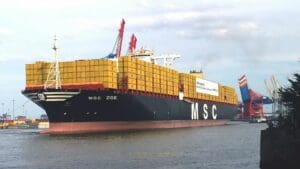[ad_1]

The International Maritime Organization (IMO) adopted tougher greenhouse gas emission targets for the global shipping industry on Friday. The IMO is a United Nations agency responsible for creating a regulatory framework for the global shipping industry.
The member states have agreed to tougher standards. The new pledge is squishy. It targets a reduction of greenhouse gas (GHG) emissions to net-zero “by or about 2050.” Previously, member states had agreed to reduce its emissions by half by 2050. The interim goals include cutting greenhouse gas emissions “by at least 20 percent, striving for 30 percent, by 2030” and “by at least 70 percent, striving for 80 percent, by 2040.”
Around 80% of global trade by volume and over 70% by value are carried by sea. Most ships burn heavy fuel oil, and this sector is responsible for 3% of GHG emissions.
The United States and other leading industrial nations sought even tougher standards. The Ocean Conservancy and the Clean Shipping Coalition criticized the agreement as not going far enough. But a bigger issue than whether the new targets are enough to sufficiently help slow global warming is the enforcement of these new targets.
The enforcement of IMO conventions depends upon the member nations enforcing the provisions of IMO conventions for vessels that carry their flags. Each merchant ship is required by international law to be registered in a registry created by a country, and a ship is subject to the laws of that country. The nations with the most flagged vehicles are Panama, China, Singapore, the Marshall Islands, and Liberia. A key question for hitting these targets is whether nations like Panama, the Marshall Islands – and other leading shipping nations including Liberia, Malta, Greece and the Bahamas – will actively monitor, encourage and penalize companies not on track to meet the new standards. Further, even if member states have the will to enforce treaty obligations, the unauthorized flag use is a growing problem. This is a practice where a ship uses a state’s flag without its knowledge.
To meet the 2030 goals, the industry will need to retrofit the ships’ engines to allow the burning of alternative fuels with smaller carbon footprints such as ammonia, natural gas and ethanol can be used to help attain 2030 goals. But to reach 2050 goals, the accelerated adoption of alternative propulsion systems and the use of green hypdrogen will be necessary. New technologies are being explored including high tech “sails” mounted to a ship’s deck.
But rather than retrofit, it may be cheaper just to replace old ships with new ships built from the ground up to be sustainable. A cargo ship has a lifespan of 25 to 30 years after which the ships become too expensive to operate. As of 2022, the average age of all ships in the world merchant fleet was just over 20 years. In short, the age of the global fleet might be good news in terms of embracing green technology and better fuels.
Nevertheless, the costs could be massive. Around 100,000 vessels will be affected by this energy transition. A small container ship can cost around $30 million, while a larger bulk carrier can cost over $500 million. A large ocean carrier, like Maersk, has over 700 ships. It has been estimated that $1.4 to $1.9 trillion dollars will need to be invested to hit net zero goals.
Other technological hurdles remain. Just because a pilot program using a new technology or fuel shows promise does not mean that technology can be produced at scale. Embracing green hydrogen, for example, not only requires a vast buildout of plants, but it also requires ports to develop a new storage and piping infrastructure.
[ad_2]
Source link












